Beef Wellington Recipe – Juicy, tender, and showstopping beef tenderloin wrapped in prosciutto slices, mushroom duxelles, and a flaky crust. The wine-infused sauce takes it over the top. Serving this beauty at your next gathering will get you rave reviews!
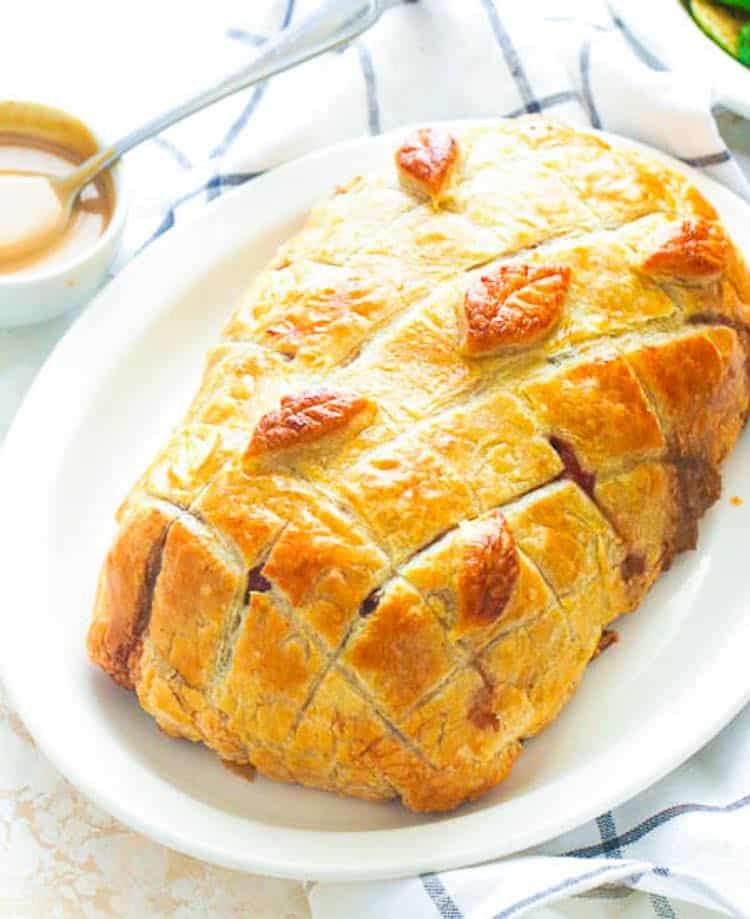
A few years ago, my brother celebrated Christmas in London. His colleague’s parents served this outstanding holiday dish. And when he returned, he asked me if I could make it for our family.
I remember how challenging it was the first time I made Beef Wellington. But of course, who can say no to family, right? So, I found a more straightforward version while honoring the traditional ingredients for a delicious result!
Content…What Is It? |
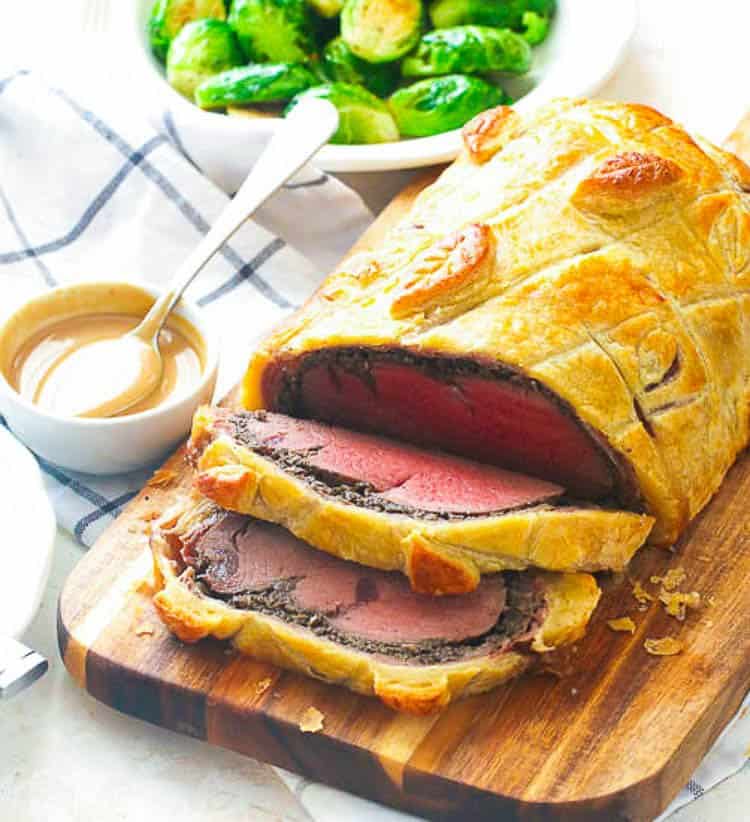
What Is Beef Wellington?
I’ve heard (and read) rumors that the 1st Duke of Wellington, Arthur Wellesley, is somehow connected to Beef Wellington. However, it’s just a rumor.
Traditionally, it is a tenderloin wrapped in pâté (sorry, purists, I left this one out), duxelles (a delicious mushroom mixture), dry-cured ham, and puff pastry. Then, bake it to a beautiful golden brown for a sensational centerpiece.
Recipe Ingredients
- Duxelles – Mushrooms, garlic, thyme, olive oil, salt, and pepper create a delicious paste to coat the tenderloin.
- Beef – Tenderloin is the traditional choice because it cooks quickly.
- Wrappings – Prosciutto, thyme, Dijon mustard, puff pastry, a little flour, and egg wrap up the tenderloin neatly.
- Wine Sauce – Butter, onion, garlic, thyme, wine, beef stock, heavy cream, Dijon, salt, and pepper provide a decadent sauce.
How to Make Beef Wellington

Duxelles
- Chop – Put the mushrooms, onions, garlic, and thyme in a food processor and pulse until finely chopped. (Photos 1-3)
- Saute – Heat a large saute pan over medium heat, then add butter or olive oil. Add the mushroom mixture, and sauté for 15-20 minutes or until most of the liquid has evaporated. (It’s essential to remove as much moisture as possible so the bottom of the pastry doesn’t get soggy.) Season with salt and pepper and set aside to cool. (Photo 4)

Beef Tenderloin
- Shape – If the tenderloin isn’t evenly thick, even it out by tucking the thinner end under for a rectangular shape. Tie the tenderloin into a log with kitchen twine in about six places to hold its shape while searing. (Photo 5)
- Season the tenderloin with salt and pepper on all sides.
- Sear – Heat oil over high heat in a large oven-safe skillet. Once it’s hot, add tenderloin, turn the stove down to medium-high heat, and sear for 2 minutes per side. (Photo 6)
- Cool – Transfer to a plate and let it cool slightly. Remove the twine, and brush the seared tenderloin with optional Dijon mustard.

Wrapping

- Prosciutto – Lay a long piece of plastic wrap (about 15″×15″) on your work surface. Carefully arrange the prosciutto slices on the plastic wrap in an even layer, overlapping them slightly. It should be large enough to cover the entire tenderloin. (Photos 7-8)
- Duxelles – Spread the mushroom mixture evenly on the prosciutto with a spatula. (Photo 9)
- Tenderloin – Using the plastic wrap, roll the tenderloin up (including the ends) in the prosciutto and duxelles, completely enclosing it so everything stays together and retains a rectangular shape. (Photos 10-11)
- Chill it in the fridge for 30 minutes so it keeps its shape. Preheat oven to 425℉ (220℃).
- Puff Pastry – Roll your puff pastry into a rectangular shape on a lightly floured surface. Measure and ensure that the pastry is long enough to go all the way around the tenderloin. You may have to seal two sheets together to make it longer. (Photo 12)
- Beef – Remove the tenderloin from the fridge and carefully cut the plastic wrap off. Transfer the meat to the middle of the puff pastry. Slowly wrap the beef in the puff pastry. Cut off extra pastry ends, reserving for decoration if desired. (Photos 13-15)
- Decorate – Cut decorative leaves from the leftover pastry dough and arrange them on the wrapped beef tenderloin. Chill it for 10-15 minutes. Brush the top and sides of the pastry with egg wash, then make slits on top of the wrapped beef with a knife to create steam vents. Place on a baking sheet. (Photo 16)
- Bake 30-40 minutes or until the puff pastry browns to a beautiful golden. If the pastry browns too fast, tent it with foil. Cooking time will vary depending on the meat’s thickness and your preference; an instant-read thermometer will read 125-130°F (50-55℃) for medium-rare.
- Rest – When the beef has reached the desired doneness, take it out of the oven and let it rest for 10-15 minutes before slicing. However, leaving it too long before cutting might cause soggy puff pastry.
Wine Sauce
- Saute – Heat a small pan with butter or oil. Then add onions, garlic, bay leaf, and thyme; sauté for 1 to 2 minutes.
- Wine – Pour in the wine and stock and continue cooking until sauce has reduced by about half. Remove from the heat and strain.
- Cream – Pour the liquid mixture back into the pan and add heavy cream and mustard. Cook for a few minutes until sauce thickens—add salt and pepper to taste.
- Serve – Drizzle it over your sliced Beef Wellington.
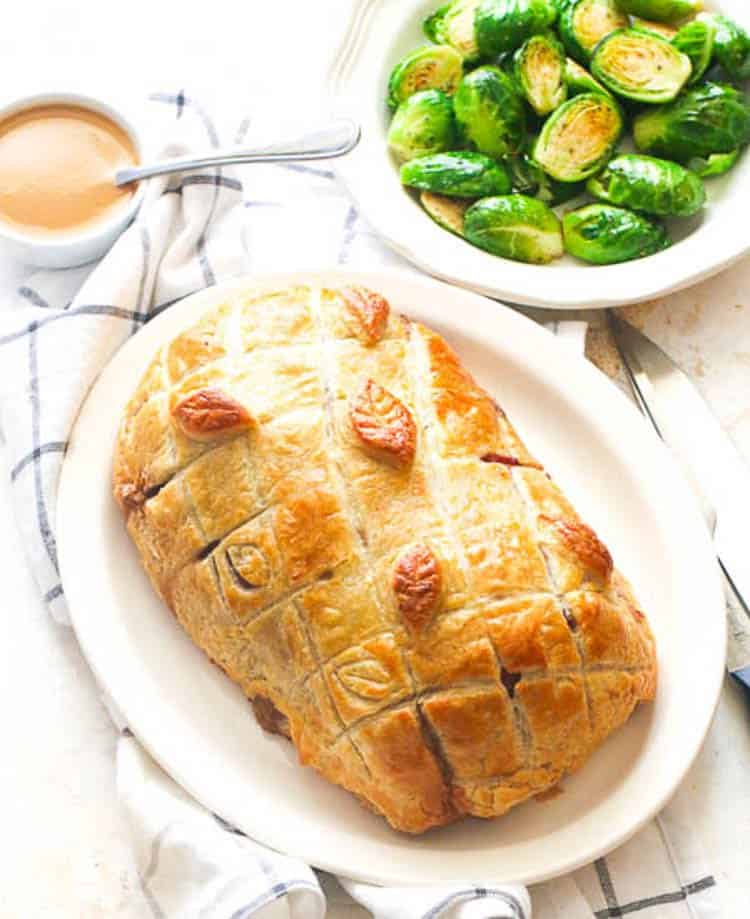
Recipe Variations
- Chicken Wellington – Chicken breasts or thighs wrapped in prosciutto and puff pastry are amazing.
- Salmon Wellington delivers a seafood twist on a classic with salmon fillets instead of beef.
- Mini Beef Wellingtons – Make gorgeous individual servings with tenderloin medallions.
- Pork Wellington – Similar to the classic recipe, but using pork tenderloin instead of beef.
Tips and Tricks
- Cook the mushroom duxelles until all excess liquid evaporates to avoid soggy pastry.
- Wrap the tenderloin tightly to prevent holes or gaps, resulting in a better shape and even cooking.
- Roll the puff pastry as thin as possible without tearing so it cooks golden brown before the beef overcooks.
- Brush the inside of the puff pastry with an egg wash before wrapping the tenderloin to reduce the risk of sogginess.
- An instant-read meat thermometer saves on the guesswork. When it reaches 125℉ (50℃), your tenderloin is medium-rare.
Make-Ahead and Storage Instructions
You can make your Beef Wellington ahead! Follow the instructions up to and including wrapping the beef in plastic wrap. Store it in the fridge until the next day or in the freezer for 2-3 months. Thaw or remove it from the refrigerator, roll out your puff pastry, unwrap the beef, wrap it in the puff pastry, and bake.
Leftovers are a lifesaver! Slice Beef Wellington into individual servings and refrigerate in an airtight container for 3-4 days. Or freeze individual slices in freezer ziplock bags for up to 2 months.
To reheat frozen Beef Wellington, pop it straight into a 400℉ (200℃) oven for 15 minutes.
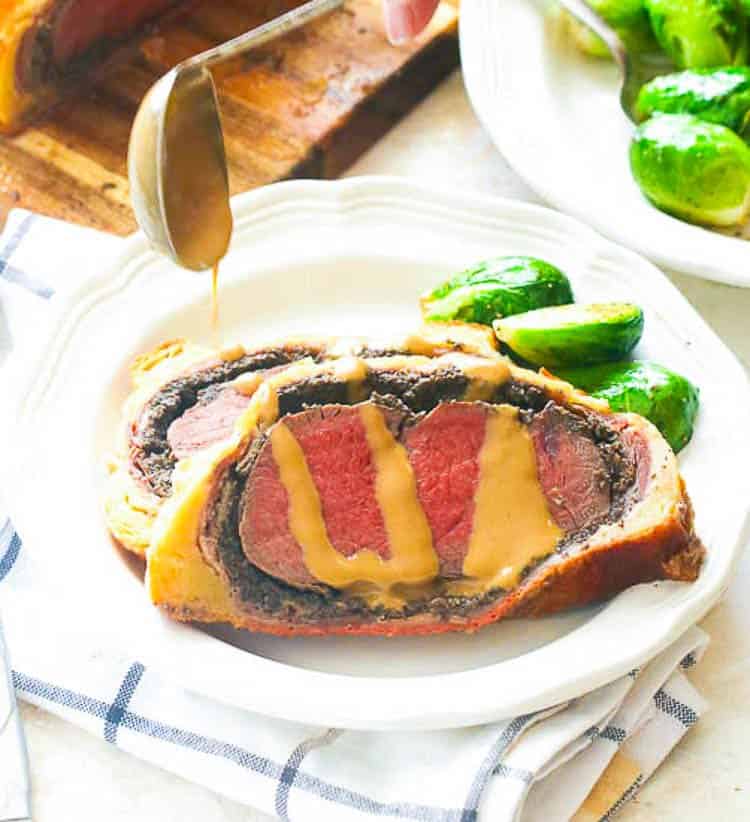
What to Serve With Beef Wellington
Beef Wellington is a one-pot meal. But sauteed Brussels sprouts, green beans, and a tossed salad complement beef well. Finish this heavy meal with a lighter dessert, like a fruit tart or ambrosia salad.
More Holiday Main Dishes to Choose From
Watch How to Make It
[adthrive-in-post-video-player video-id=”vcqTGSSZ” upload-date=”2020-12-02T08:23:23.000Z” name=”Beef Wellington” description=”Juicy, tender, and showstopper BEEF WELLINGTON wrapped in prosciutto slices, mushroom duxelles, and a flaky crust then served with a wine-infused sauce. Serving this dish at your next gathering will get you rave reviews from everyone!” player-type=”collapse” override-embed=”false”]
This blog post was originally published in December 2020 and has been updated with additional tips, new photos, and a video.
Beef Wellington
Ingredients
For the Duxelles
- 1 pound (455g) mushrooms, roughly chopped
- ¼ cup diced onion
- 2 teaspoons (10g) minced garlic
- 2 teaspoons (2g) thyme, minced
- 2 tablespoons (28g) butter or olive oil
- salt and pepper to taste
For the Beef
- 2 pounds (907g) center-cut beef tenderloin
- salt and pepper
- ½-1 cup (118-236ml) Dijon mustard (depending on the size of the tenderloin)
- 6-8 ounces (170-226g) thinly sliced prosciutto
- 12-16 ounces (340-450g) puff pastry, thawed
- flour for dusting
- 1 large egg, lightly beaten (for egg wash)
Beef Wellington Sauce
- 2 tablespoons (28g) butter or olive oil
- ⅓ small onion, sliced or chopped
- 3 cloves garlic, peeled and smashed
- 1 bay leaf
- 2 sprigs fresh thyme
- ½ cup (118ml) wine
- 3 cups (710ml) beef stock
- 1 cup (236ml) heavy cream
- 2 tablespoons (30ml) Dijon mustard
- salt and pepper to taste (optional)
Instructions
The Duxelles
- Place mushrooms, onions, garlic, and thyme in a food processor and pulse until finely chopped.
- Heat a large saucepan or saute pan over medium heat, then add butter or olive oil.
- Remove mushrooms from the processor and add to the saucepan. Sauté for 15-20 minutes or until most of the liquid has evaporated. Removing as much moisture as possible is essential so the bottom of the pastry doesn’t get soggy—season with salt and pepper and set aside to cool.
The Beef
- If the tenderloin is uneven, tuck the smaller or narrow end under itself. You want the tenderloin to be even in thickness so it bakes evenly.
- Tie the tenderloin into a log in about 6 places with kitchen twine so it keeps its shape while searing. Then, generously season the beef tenderloin with salt and pepper on all sides.
- Heat oil over high heat in a large oven-safe skillet. Once the oil is hot, place the tenderloin in the pan. Turn the heat down to medium-high and cook for two minutes per side or until well-seared. Transfer to a plate, let it cool slightly, and remove the twine.
- Optionally, brush the seared tenderloin with Dijon mustard all over.
- Lay a long plastic wrap on the board or work surface. It should be about 15 inches wide and long.
- Carefully place the prosciutto slices on top of the plastic wrap, arrange them in an even layer, and overlap the pieces slightly. The layer should be large enough to cover the entire tenderloin.
- Spread the mushroom mixture evenly over the prosciutto with a spatula.
- Lay the seared tenderloin crosswise on the duxelle. Using the plastic wrap, roll the tenderloin up and roll up the sides if necessary to completely enclose the beef. Everything should stay together so the beef tenderloin retains a rectangular shape—place in the fridge for 30 minutes to firm it up.
- Preheat oven to 425℉ (220℃).
- Flour a board or clean surface. Then, roll out your puff pastry into a rectangle shape. Measure to the pastry is long enough to go all the way around the tenderloin. You may have to seal two sheets together to make it long enough, especially if using premade puff pastry.
- Remove the beef from the fridge and carefully remove the plastic wrap. Transfer the tenderloin to the middle of the puff pastry.
- Slowly wrap the beef in the puff pastry and cut off any extra pastry ends. Reserve for decorations if desired.
- Cut out decorative leaves from the extra pastry. Arrange decoratively on the wrapped beef tenderloin. Place in the refrigerator and let it chill for 10-15 minutes.
- Brush the top and sides of the pastry with egg wash, then slit the top of the wrapped beef with a knife to create vents for the steam to be released. Place it on a baking sheet.
- Bake for 30-40 minutes until the pastry is golden brown. If the beef is browning too fast, tent with foil. Cooking times will vary depending on the thickness and preferred doneness. An instant-read thermometer will tell you when it reaches the desired temperature. Rare: 115-120°F (46-49°C), medium-rare: 120-125°F (49-52°C), medium: 130 to 135°F (54-57°C), medium-well: 140-145°F (60-63°C), well-done: 150-155°F (66-68°C).
- When the beef has reached the desired temperature, remove it from the oven and let it rest for 10-15 minutes before slicing. If you leave it too long without slicing, it might get soggy. Enjoy!
Beef Wellington Sauce
- Heat a small pan with butter or oil. Add onions, garlic, bay leaf, and thyme, and then sauté for 1-2 minutes.
- Pour in the wine and stock and continue cooking until sauce has reduced by about half.
- Remove from the heat and strain. Put the liquid mixture back into the pan and add heavy cream and mustard. Cook for a few minutes until the sauce thickens—salt and pepper to taste.
- Serve with Beef Wellington.
Tips & Notes:
- Cook the mushroom duxelles until all excess liquid evaporates to avoid soggy pastry.
- Wrap the tenderloin tightly to prevent holes or gaps, resulting in a better shape and even cooking.
- Roll the puff pastry as thin as possible without tearing so it cooks golden brown before the beef overcooks.
- Brush the inside of the puff pastry with an egg wash before wrapping the tenderloin to reduce the risk of sogginess.
- An instant-read meat thermometer saves on the guesswork.
Rare: 115-120°F (46-49°C)
Medium-rare: 120-125°F (49-52°C)
Medium: 130 to 135°F (54-57°C)
Medium-well: 140-145°F (60-63°C)
ell-done: 150-155°F (66-68°C) - Please keep in mind that nutritional information is a rough estimate and can vary greatly based on the products used.
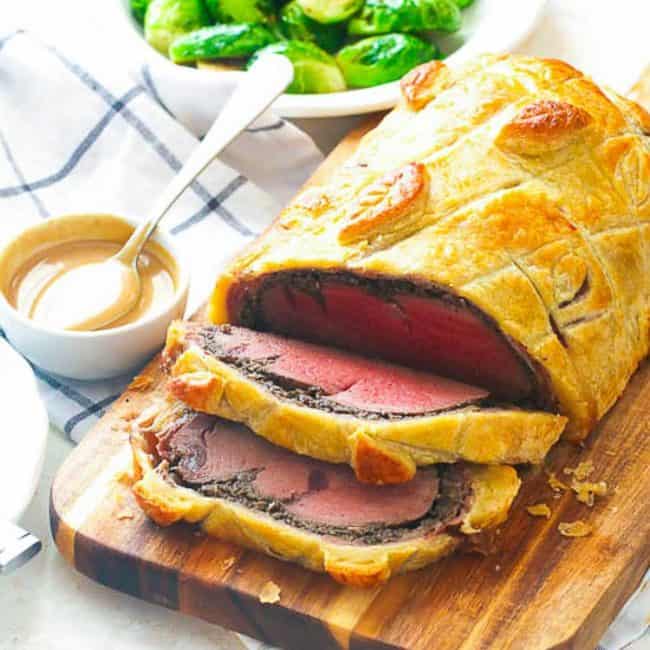

Lallie says
Wow wow wow! This an an amazing up to date recipe, easy to follow and really a dream to eat this masterpiece by following your hard work with every detail. WISHING YOU AND YOUR FAMILY ALWAYS ABUNDANTLY FOR A BLESSED NEW YEAR
ImmaculateBites says
Hi Callie,
Thank you for your enthusiastic feedback and warm wishes! It’s wonderful to hear that the Beef Wellington recipe was a success and that you enjoyed both the process and the final dish. Beef Wellington, with its rich flavors and elegant presentation, is indeed a special meal that can make any occasion feel more festive.
As you continue your culinary adventures in the New Year, feel free to reach out if you’re looking for more recipes, cooking tips, or if you have any specific culinary interests you’d like to explore. It’s always a pleasure to share ideas and inspire each other in the kitchen.
Wishing you a fantastic New Year filled with joy, prosperity, and of course, delicious food! Here’s to more culinary discoveries and delightful meals in the year ahead. ️
Shelley says
Can you use something other than mushrooms perhaps a spread (no olives either). I’m a picky eater???